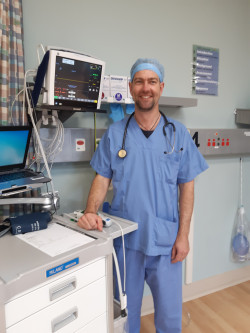

Marco Meijer, head of the anaesthetics department at Whanganui Hospital.
10 October 2019
The benefits of being in good physical shape before having surgery will be the focal point of a public display and inter-action at Whanganui Hospital on October 16.
That date is National Anaesthesia Day, and staff at the hospital will mark it by promoting the Fit For Surgery, Fit For Life programme which has been running for a year and has had a profound effect on people’s lives.
The programme is the brainchild of Marco Meijer, who heads the nine-strong anaesthetics department at the hospital, and it is a project that has garnered national attention.
It was prompted by difficult personal experience when, some years ago, a particularly obese patient of Meijer’s died after having surgery.
"I had a patient whom I anaesthetised, who died in the ward two days after surgery, and that really made me decide deep down, we really need to do something about this problem," he said.
“Then I saw the data of how badly overweight people were doing during and post-operation.
"There was just no good solution out there, so I thought: Let's try something new.”
Highlighting the importance of not being overweight inevitably raises the serious health risks of being too heavy and of not being “fit for surgery”.
Weight is the primary target of the programme, with the aim being to get patients down to a body mass index [BMI] of less than 40.
“If your body mass index is above 40, the risks accumulate with complications and technical issues,” Meijer said.
These complications include finding a vein to insert an IV line to administer anaesthetic; needing different tables and equipment for particularly heavy people; thick necks affecting airways; heart and lung problems that can impact on breathing under anaesthesia; and obstructive sleep apnoea, a condition in which people stop breathing while asleep.
“In surgery, there can be difficulties getting through layers of fat which means the patient is in surgery longer which is an added risk, while being overweight is associated with diabetes which makes wound infections more likely, and overweight patients are more prone to blood clotting,” said Meijer.
“Post-operation it can be problematic to give pain medication as that can affect breathing.”
The Fit For Surgery, Fit For Life programme has been developed with in-put from patients and dieticians, and is supported by Sport Whanganui, making use of services available in the community.
More than 80 people are currently working on reducing their weight and getting into a healthier lifestyle, and 26 people have reached their BMI target and are ready for surgery.
And there are a number who have completed surgery and are now receiving the follow-up service which helps them keep their weight down and continue the good habits they have picked up. This support runs for 12 months post-operation.
A vital player in the programme is Sport Whanganui’s Christine Taylor, a registered nurse and the Fit For Surgery, Fit For Life navigator who works one-to-one with the patients.
“It is a wrap-around service specific to each individual. Every plan is different; every journey is different – there’s no one-size-fits-all,” Taylor said.
“We look at all areas of a person’s life – their health; their family; their lifestyle; even their shopping habits.

Fit For Surgery, Fit For Life was a winner at the Whanganui District Health Quality Awards in September. Pictured are Christine Taylor, project co-ordinator Felicity Spencer, Marco Meijer and Deb Byers, with presenter Mary Bennett.
“One patient found they had become more mobile, more active and that their pain had reduced to such an extent that they decided not to have surgery. Many others find that they are doing a lot more and suffering less pain and discomfort.”
Meijer is heartened by the success stories of those who have dramatically changed their lifestyles.
He, Taylor and other staff will be sharing that inspiration with the public on October 16 when their display will be in the main hospital entrance and they will be happy to chat with people and explain how getting fit for surgery can make you fit for life.



